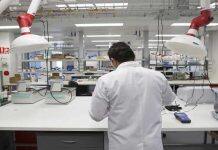

Delivery of safe and high-quality drinking water is an essential public service, but it’s not easy to monitor water quality in real-time close to customers’ homes.
Thanks to a new research partnership with the Natural Sciences and Engineering Research Council of Canada, TELUS and the Regional District of North Okanagan, researchers at UBC’s Okanagan campus will begin to address this gap by leveraging new sensors to wirelessly monitor water quality in the distribution system.
This new smart monitoring solution aims to improve how municipalities monitor water and its quality at the tap for thousands of residents across the Okanagan.
“Our eventual goal is to improve drinking-water-system-management and enhance the safety of residents across British Columbia,” says Dr. Nicolas Peleato, Assistant Professor with UBCO’s School of Engineering. “Through the use of these sensors, water providers such as municipalities and regional districts will be able to identify water quality issues more accurately and faster than what is currently feasible.”
TELUS is currently working on the development of Smart City technologies in urban and rural applications to enhance the lives of residents through improved safety and better connectivity.
“Using technology for good and providing safe water and food is in TELUS’ DNA, and we are excited to be collaborating with UBCO on this project,” says Chief Technology Officer Ibrahim Gedeon. “Bringing together technology leaders, who have a genuine desire to improve the safety and wellbeing of Canadians, with some of UBCO’s excellent research expertise and knowledge will improve the lives of British Columbians, and support the region in becoming digitally enabled with smart technology solutions.”
The smart sensors will be configured in a system that will identify conductivity, oxidation reduction potential and water temperature using processing and communication hardware. The acquired data will then be sent through mobile networks to the TELUS Smart City products for interpretation and evaluation.
“A lack of adequate monitoring can have significant consequences,” adds Dr. Peleato. “Technology that offers real-time monitoring and evaluation, delivers an important safeguard for water providers and users to ensure their drinking water stays safe. Our municipal partner is excited about the immediate and positive impact this research will have on their water systems.”
An important part of the research will be developing models to help the software quickly and accurately respond to the data allowing for real-time responses. The researchers are working to develop a wireless low-cost sensor for water quality monitoring. The intended outcome, notes Dr. Peleato, is that connection level sensors help future products let users know their water quality with a simple interface that will visualize the data for consumers.
There are several advantages—for both the customer and the water utility—to monitoring chlorine residuals, turbidity and other relevant water quality indicators closer to the point of use. With access to water quality data from the distribution system, the water utility can better respond to quality issues before receiving a complaint. This will enable improved monitoring and management of the system.
“Connecting dispersed sensors with a 5G network like that of TELUS allows for real-time water quality monitoring, predicting water quality changes and taking proactive measures to correct for such changes in a timely manner,” says Dr. Anas Chaaban, UBCO Assistant Professor of Electrical Engineering and project co-investigator. “This new collaboration will provide greater customer assurance and confidence in their drinking water.”








































